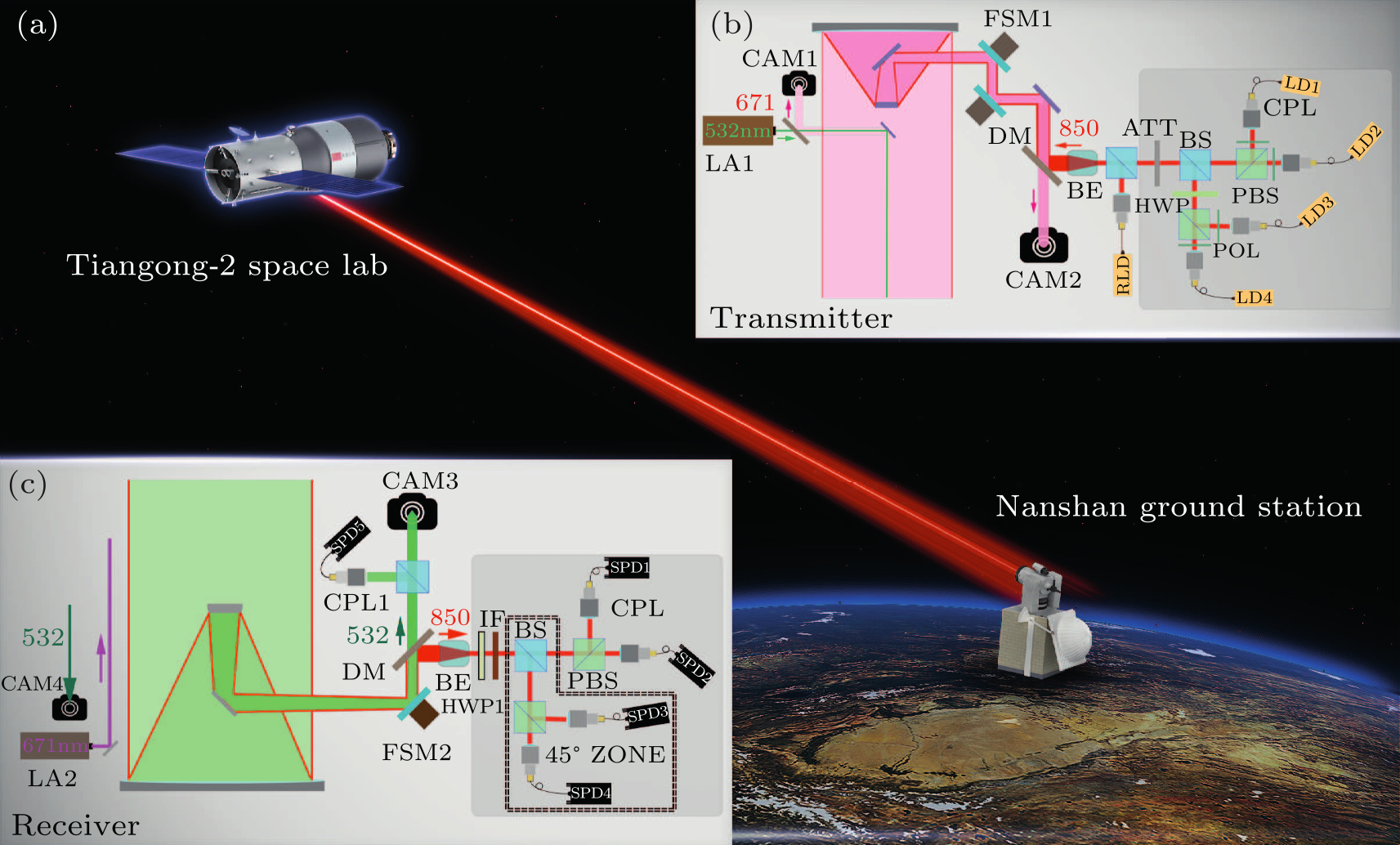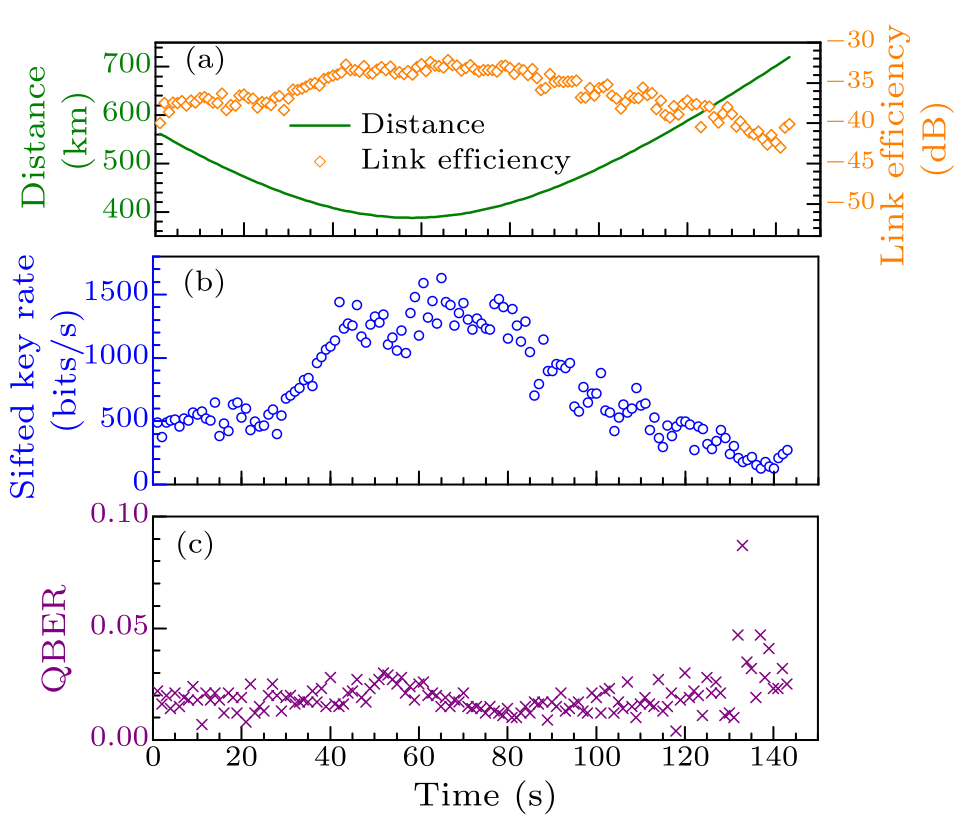**Corresponding author. Email: pcz@ustc.edu.cn; jywang@mail.sitp.ac.cn; pan@ustc.edu.cn

Fig. 1. Schematic diagram of the experimental setup. (a) Overview of the space-to-ground QKD. (b) Schematic of the decoy-state QKD transmitter. (c) Schematic of the decoy-state QKD decoder in the Nanshan ground station equipped with a 1200-mm-aperture telescope. LA1: green laser (532 nm), CAM1: coarse camera, CAM2: fine camera, LD: laser diode, RLD: reference laser diode, FSM1: fast steering mirror, HWP: half-wave plate, POL: polarizer, PBS: polarization beam splitter, BS: beam splitter, ATT: attenuation, LA2: red laser (671 nm), CAM3: fine camera, CAM4, coarse camera, CPL: coupler, DM: dichroic mirror, IF: interference filter, FSM2: fast steering mirror, BE: beam expander, SPD: single photon detector.
| Zenith angle | Main procedure | Time |
|---|---|---|
| of a typical pass | ||
| Beneath horizon | System initialization | – |
| Horizon to $65^\circ$ | Orientation initialization | $\sim$200 s |
| $65^\circ$ to $60^\circ$ | ATP | $\sim$15 s |
| $65^\circ$ to $55^\circ$ | Stable quantum link settlement | $\sim$27 s |
| $55^\circ$ to $-65^\circ$ | Quantum communication | $\sim$130 s |
| Beneath $-65^\circ$ | Data processing | – |

Fig. 2. Experimental results for one pass of space lab. (a) The distance of the space lab and the ground station and the link efficiency as a function of time. (b) The sifted key rate as a function of time. (c) Observed quantum bit error rate as a function of time.
| $T$ | $Q_\mu$ | $Q_\nu$ | $Y_0$ |
|---|---|---|---|
| 143 s | $3.13\times10^{-5}$ | $1.88\times10^{-5}$ | $8.33\times10^{-7}$ |
| $E_\mu$ | $E_\nu$ | $R_{\rm total}$ | $R_{\rm pulse}$ |
| $1.84\%$ | $2.14\%$ | 13119 bits | $1.83\times10^{-6}$ |
| [1] | Vernam G S 1926 Trans. Am. Inst. Electr. Eng. XLV 295 | Cipher Printing Telegraph Systems For Secret Wire and Radio Telegraphic Communications
| [2] | Shannon C E 1949 Bell Labs Tech. J. 28 656 | Communication Theory of Secrecy Systems*
| [3] | Bennett C H and Brassard G 1984 Conf. on Computers, Systems and Signal Processing (Bangalore India December 1984) 175 |
| [4] | Bennett C H and Brassard G 1989 SIGACT News 20 78 | Experimental quantum cryptography: the dawn of a new era for quantum cryptography: the experimental prototype is working]
| [5] | Buttler W T, Hughes R J, Kwiat P G, Lamoreaux S K, Luther G G, Morgan G L, Nordholt J E, Peterson C G and Simmons C M 1998 Phys. Rev. Lett. 81 3283 | Practical Free-Space Quantum Key Distribution over 1 km
| [6] | Hughes R J, Nordholt J E, Derkacs D and Peterson C G 2002 New J. Phys. 4 43 | Practical free-space quantum key distribution over 10 km in daylight and at night
| [7] | Schmitt-Manderbach T, Weier H, Fürst M, Ursin R, Tiefenbacher F, Scheidl T, Perdigues J, Sodnik Z, Kurtsiefer C, Rarity J G, Zeilinger A and Weinfurter H 2007 Phys. Rev. Lett. 98 010504 | Experimental Demonstration of Free-Space Decoy-State Quantum Key Distribution over 144Â km
| [8] | Wang J Y, Yang B, Liao S K, Zhang Li, Shen Q, Hu X F, Wu J C, Yang S J, Jiang H, Tang Y L, Zhong B, Liang H, Liu W Y, Hu Y Hand Huang Y M, Qi B, Ren J G, Pan G S, Yin J, Jia J J, Chen Y A, Chen K, Peng C Z and Pan J W 2013 Nat. Photon. 7 387 | Direct and full-scale experimental verifications towards groundâsatellite quantum key distribution
| [9] | Peng C Z, Zhang J, Yang D, Gao W B, Ma H X, Yin H, Zeng H P, Yang T, Wang X B and Pan J W 2007 Phys. Rev. Lett. 98 010505 | Experimental Long-Distance Decoy-State Quantum Key Distribution Based on Polarization Encoding
| [10] | Liu Y, Chen T Y, Wang J, Cai W Q, Wan X, Chen L K, Wang J H, Liu S B, Liang H, Yang Li, Peng C Z, Chen K, Chen Z B and Pan J W 2010 Opt. Express 18 8587 | Decoy-state quantum key distribution with polarized photons over 200 km
| [11] | Korzh B, Lim C C W, Houlmann R, Gisin N, Li M J, Nolan D, Sanguinetti B, Thew R and Zbinden H 2015 Nat. Photon. 9 163 | Provably secure and practical quantum key distribution over 307â km of optical fibre
| [12] | Shibata H, Honjo T and Shimizu K 2014 Opt. Lett. 39 5078 | Quantum key distribution over a 72ââdB channel loss using ultralow dark count superconducting single-photon detectors
| [13] | Yin H L, Chen T Y, Yu Z W, Liu H, You L X, Zhou Y H, Chen S J, Mao Y Q, Huang M Q, Zhang W J, Chen H, Li M J, Nolan D, Zhou F, Jiang X, Wang Z, Zhang Q, Wang X B and Pan J W 2016 Phys. Rev. Lett. 117 190501 | Measurement-Device-Independent Quantum Key Distribution Over a 404Â km Optical Fiber
| [14] | Peev M, Pacher C, Alléaume R, Barreiro C, Bouda J, Boxleitner W, Debuisschert T, Diamanti E, Dianati M, Dynes J F, Fasel S, Fossier S, Fürst M, Gautier J D, Gay O, Gisin N, Grangier P, Happe A, Hasani Y, Hentschel M, Hübel H, Humer G, Länger T, Legré M, Lieger R, Lodewyck J, Lorünser T, Lütkenhaus N, Marhold A, Matyus T, Maurhart O, Monat L, Nauerth S, Page J B, Poppe A, Querasser E, Ribordy G, Robyr S, Salvail L, Sharpe A W, Shields A J, Stucki D, Suda M, Tamas C, Themel T, Thew R T, Thoma Y, Treiber A, Trinkler P, Tualle-Brouri R, Vannel F, Walenta N, Weier H, Weinfurter H, Wimberger I, Yuan Z L, Zbinden H and Zeilinger A 2009 New J. Phys. 11 075001 | The SECOQC quantum key distribution network in Vienna
| [15] | Sasaki M, Fujiwara M, Ishizuka H, Klaus W, Wakui K, Takeoka M, Miki S, Yamashita T, Wang Z, Tanaka A, Yoshino K, Nambu Y, Takahashi S, Tajima A, Tomita A, Domeki T, Hasegawa T, Sakai Y, Kobayashi H, Asai T, Shimizu K, Tokura T, Tsurumaru T, Matsui M, Honjo T, Tamaki K, Takesue H, Tokura Y, Dynes J F, Dixon A R, Sharpe A W, Yuan Z L, Shields A J, Uchikoga S, Legré M, Robyr S, Trinkler P, Monat L, Page J B, Ribordy G, Poppe A, Allacher A, Maurhart O, Länger T, Peev M and Zeilinger A 2011 Opt. Express 19 10387 | Field test of quantum key distribution in the Tokyo QKD Network
| [16] | Tang Y L, Yin H L, Zhao Q, Liu H, Sun X X, Huang M Q, Zhang W J, Chen S J, Zhang L, You L X, Wang Z, Liu Y, Lu C Y, Jiang X, Ma X, Zhang Q, Chen T Y and Pan J W 2016 Phys. Rev. X 6 011024 | Measurement-Device-Independent Quantum Key Distribution over Untrustful Metropolitan Network
| [17] | Briegel H J, Dür W, Cirac J I and Zoller P 1998 Phys. Rev. Lett. 81 5932 | Quantum Repeaters: The Role of Imperfect Local Operations in Quantum Communication
| [18] | Rarity J G, Tapster P R, Gorman P M and Knight P 2002 New J. Phys. 4 82 | Ground to satellite secure key exchange using quantum cryptography
| [19] | Nauerth S, Moll F, Rau M, Fuchs C, Horwath J, Frick S and Weinfurter H 2013 Nat. Photon. 7 382 | Air-to-ground quantum communication
| [20] | Yin J, Cao Y, Li Y H, Liao S K, Zhang L, Ren J G, Cai W Q, Liu W Y, Li B, Dai H, Li G B, Lu Q M, Gong Y H, Xu Y, Li S L, Li F Z, Yin Y Y, Jiang Z Q, Li M, Jia J J, Ren G, He D, Zhou Y L, Zhang X X, Wang N, Chang X, Zhu Z C, Liu N L, Chen Y A, Lu C Y, Shu R, Peng C Z, Wang J Y and Pan J W 2017 Science 356 1140 | On the Einstein-Podolsky-Rosen paradox
| [21] | Liao S K, Cai W Q, Liu W Y, Zhang L, Li Y, Ren J G, Yin J, Shen Q, Cao Y, Li Z P, Li F Z, Chen X W, Sun L H, Jia J J, Wu J C, Jiang X J, Wang J F, Huang Y M, Wang Q, Zhou Y L, Deng L, Xi T, Ma L, Hu T, Zhang Q, Chen Y A, Liu N L, Wang X B, Zhu Z C, Lu, C Y, Shu R, Peng C Z, Wang J Y and Pan J W 2017 arXiv:1707.00542 [quant-ph] | Satellite-to-ground quantum key distribution
| [22] | Ren J G, Xu P, Yong H L, Zhang L, Liao S K, Yin J, Liu W Y, Cai W Q, Yang M, Li L, Yang K X, Han X, Yao Y Q, Li J, Wu H Y, Wan S, Liu L, Liu D Q, Kuang Y W, He Z P, Shang P, Guo C, Zheng R H, Tian K, Zhu Z C, Liu N L, Lu C Y, Shu R, Chen Y A, Peng C Z, Wang J Y and Pan J W 2017 arXiv:1707.00934 [quant-ph] | Ground-to-satellite quantum teleportation
| [23] | Lo H K, Ma X and Chen K 2005 Phys. Rev. Lett. 94 230504 | Decoy State Quantum Key Distribution
| [24] | Wang X B 2005 Phys. Rev. Lett. 94 230503 | Beating the Photon-Number-Splitting Attack in Practical Quantum Cryptography
| [25] | Bai S, Wang J Y, Qiang J, Zhang L and Wang J J 2014 Opt. Express 22 26462 | Predictive filtering-based fast reacquisition approach for space-borne acquisition, tracking, and pointing systems
| [26] | Pearson D, Barnett S M, Hirota O, Öhberg P, Jeffers J and Andersson E 2004 AIP Conf. Proc. 734 299 |
| [27] | Zhang Z, Zhao Q, Razavi M and Ma X 2017 Phys. Rev. A 95 012333 | Improved key-rate bounds for practical decoy-state quantum-key-distribution systems
| [28] | Liao S K, Yong H L, Liu C, Shentu G L, Li D D, Lin J, Dai H, Zhao S Q, Li B, Guan J Y, Chen W, Gong Y H, Li Y, Lin Z H, Pan G S, Pelc, J S, Fejer M M, Zhang W Z, Liu W Y, Yin J, Ren J G, Wang X B, Zhang Q, Peng C Z and Pan J W 2017 Nat. Photon. 11 509 | Long-distance free-space quantum key distribution in daylight towards inter-satellite communication
| [29] | Ma X, Qi B, Zhao Y and Lo H K 2005 Phys. Rev. A 72 012326 | Practical decoy state for quantum key distribution
| [30] | Fung C H F, Ma X and Chau H 2010 Phys. Rev. A 81 012318 | Practical issues in quantum-key-distribution postprocessing